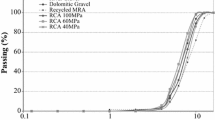Abstract
This research aims at evaluating the main risks for the durability of concrete made of industrially produced recycled aggregates called Recycled Aggregate Concrete (RAC). A characterisation of recycled aggregates is performed and their peculiarities are highlighted. A comparison between the behaviour of RAC and that of ordinary natural aggregate concrete is carried out. The influence of both the composition and the curing conditions is discussed.
The durability study is focused on the assessment of parameters representing the porous structure and concrete characteristics. Because of the high total water/cement ratio of RAC, their flow properties control their durability. It is established that RAC are characterised by significantly higher water absorption and air permeability. The diffusion of the carbon dioxide is faster, too. That leads to a weaker resistance of RAC to environmental attacks.
Since the main durability problems are caused by the fine recycled fraction, its use needs to be restricted. Another way to increase RAC durability seems to be the extended curing in wet environment.
Résumé
La recherche présentée dans ce papier a pour objectif d'évaluer la durabilité des bétons à base de granulats recyclés produits industriellement. La caractérisation des granulats recyclés est présentée en insistant sur leurs particularités. Une comparaison des performances des bétons de granulats naturels et recyclés est menée et l'influence de la composition et des conditions de cure est discutée.
L'étude de la durabilité est centrée sur l'évaluation de paramètres représentatifs de la structure poreuse et des caractéristiques du béton. En raison de l'importance du rapport eau totale/ciment, la durabilité est contrôlée par les facteurs de transfert: absorption d'eau et perméabilité à l'air élevées. La carbonatation est également plus rapide. Cela conduit à une faible résistance aux attaques environnementales et chimiques du béton de granulats recyclés.
Les principaux problèmes de durabilité sont dus à la fraction fine, le sable recyclé. Son emploi doit donc être limité. Une autre voie d'amélioration de la durabilité des bétons recyclés est la réalisation d'une cure soignée.
Similar content being viewed by others
References
Hendriks, C. F. and Pietersen, H. S., ‘Sustainable raw materials—construction and demolition waste’, RILEM Report No. 22 (RILEM, 2000).
Sagoe-Crentsil, K. K., Brown, T. and Taylor, A. H., ‘Performance of concrete made with commercially produced coarse recycled concrete aggregate’,Cement and Concrete Research 31 (5) (2001) 707–712.
Limbachiya, M. C., Leelawat, T. and Dhir, R. K., ‘Use of recycled concrete aggregate in high-strength concrete’,Mater. Struct. 33 (233) (2000) 574–580.
Québaud, M., Courtial, M. and Buyle-Bodin, F., ‘The recycling of demolition materials: basic properties of concretes with recycled aggregates from demolished buildings’, in Proceedings of R'97, International Recycling Congress (EMPA, Zurich, 1997) vol. II, 179–186.
Hansen, T. C., ‘Recycling of Demolished Concrete and Masonry’, RILEM Report No. 6. (E & FN Spon, London, 1992).
Hadjieva-Zaharieva, R., ‘Durabilité des bétons à base de granulats recyclés’, Doctoral Thesis, University of Artois (1998).
Aitcin, P. C., ‘Does concrete shrink or does it swell?’,Concrete International 21 (12) (1999) 77–80.
Basheer, L., Kropp, J. and Cleland, D. J., ‘Assessment of the durability of concrete from permeation properties: a review’,Construction and Building Materials 15 (2–3) (2001) 93–103.
Québaud, M., Zaharieva, R. and Buyle-Bodin, F., ‘Le comportement des bétons incluant des granulats recyclés’,Revue Française de Génie Civil 2 (8) (1998) 969–984.
Hadjieva-Zaharieva, R., Ramos-Quebaud, M., Wirquin, E. and Buyle-Bodin, F., ‘Opportunities for Implementation of Recycled Aggregates in Production of Durable Concrete in Building Construction’, in Proceedings of Second International Symposium: Cement and Concrete Technology in the 2000s, (TCMB, Istanbul, 2000) vol. 2, 361–370.
Weber, S. and Reinhardt, H., ‘Improved durability of high strength concrete due to autogenous curing’, in Proceedings of Fourth CANMET/ACI Int. Conf. on Durability of Concrete, ACI SP-170 (1997) Vol. 1, 93–121.
Pigeon, N. and Pleau, R., ‘Durability of Concrete in Cold Climates’, (E&FN SPON, London, 1995).
Wirquin, E., Hadjieva-Zaharieva, R. and Buyle-Bodin, F., ‘Utilisation de l'absorption d'eau des bétons comme critère de leur durabilité-application aux bétons de granulats recyclés’,Mater. Struct. 33 (230) (2000) 403–408.
Balayssac, J. P., ‘Relations entre performances mécaniques, microstructure et durabilité des bétons’, Doctoral Thesis INSA of Toulouse (1992).
Perraton, D., Carles-Gibergues, A., Aitcin, P.C. and Thenoz, B., ‘Air permeability measurement’, in Proceedings of Pore structures and Permeability of Cementitious Materials, Nov 1988, Boston, USA, MRS, Roberts and Skalny editors, Pittsburgh, Pennsylvania, Vol. 137.
Wainwriht, P. J. and Cabrera, J. G., ‘Use of demolition concrete to produce durable structural concrete’, Environmental Aspects of Construction with Waste Materials, Gourmans, Van der Sloot and Aalbers editors, 1994, Elsevier Science.
Balayssac, J. P., Détriché, C. H. and Grandet, J., ‘Effects of curing upon carbonation of concrete’,Construction and Building Materials 9 (2) (1995) 91–95.
Author information
Authors and Affiliations
Additional information
Editorial Note Prof. F. Buyle-Bodin is a RILEM Senior Member.
Rights and permissions
About this article
Cite this article
Buyle-Bodin, F., Hadjieva-Zaharieva, R. Influence of industrially produced recycled aggregates on flow properties of concrete. Mat. Struct. 35, 504–509 (2002). https://doi.org/10.1007/BF02483138
Received:
Accepted:
Issue Date:
DOI: https://doi.org/10.1007/BF02483138




